Hopi Pueblo Seated Koyemsi - Mudhead Katsina Doll with Drum - C4048Q
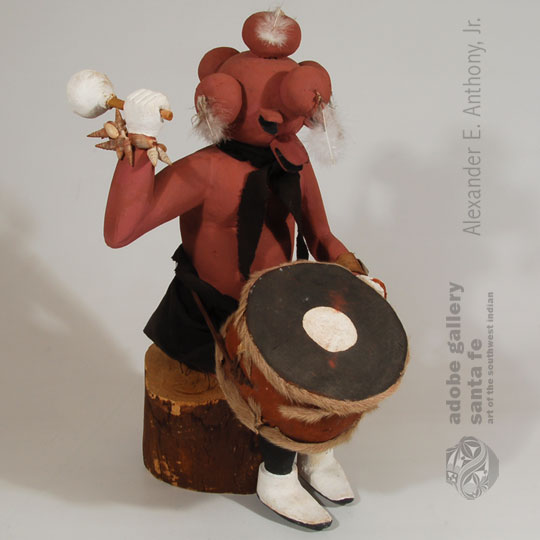 There are several Mudheads, differing slightly in appearance and conduct, maybe as many as 10 or so. All wear knobbed masks of cotton cloth, stained with the same pink clay that is used on their bodies. The knobs of the masks are filled with cotton balls and seeds. Wrapped around the base of the mask is a scarf. They dress solely in black cloth kilts.
There are several Mudheads, differing slightly in appearance and conduct, maybe as many as 10 or so. All wear knobbed masks of cotton cloth, stained with the same pink clay that is used on their bodies. The knobs of the masks are filled with cotton balls and seeds. Wrapped around the base of the mask is a scarf. They dress solely in black cloth kilts.
At Hopi, he is a curer, magician, dance director, warrior, messenger, sage or even a fool. He also may appear in the guise of any katsina by donning the clothing of that katsina. The Koyemsi appear as interlocutors between katsinas and humans. They serve religious and secular functions. They function as chiefs and as clowns at various times. They are probably the most popular and recognized of all masked dancers. They appear in almost every ceremony as clowns, drummers, announcers of dances, and many other roles.
To purchase or read more click here..
#adobegallery #HopiPueblo #Katsina #Kachina #Doll #SouthwestIndianArt #PuebloArt #SantaFeNM
Acoma Pueblo Black on White Pottery Gourd Jar by Juana Leno - C4058E
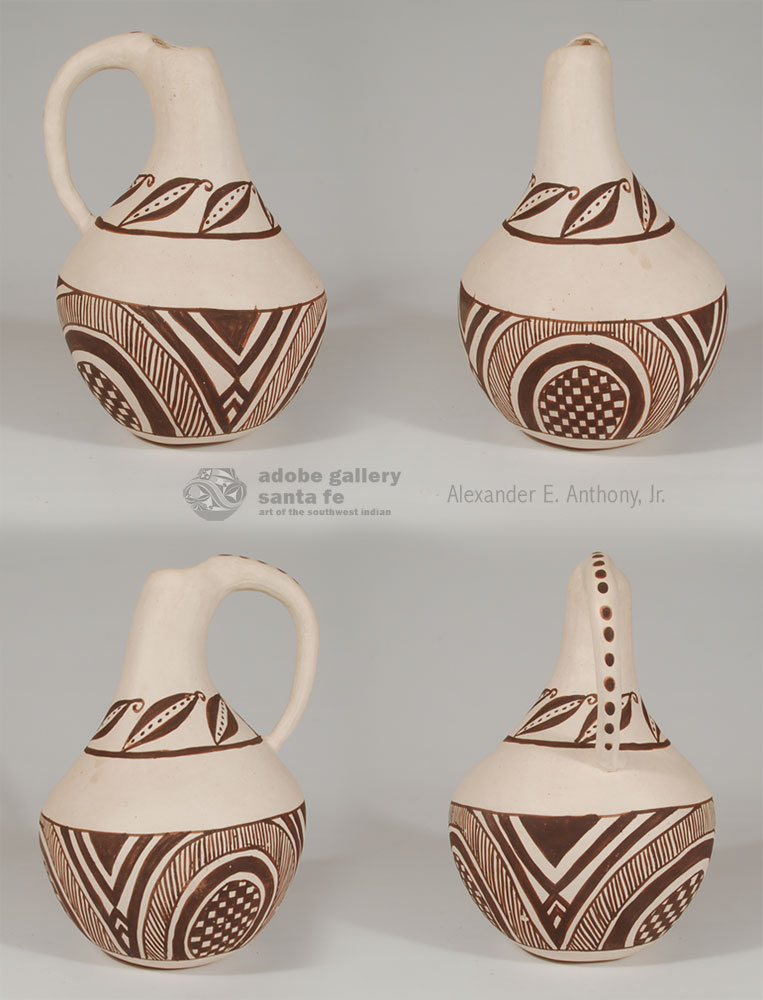 This is Juana Leno's copy of a 1902 vessel which she made in 1994. She wrote on the underside "canteen copy from 1902 12-6-94."
This is Juana Leno's copy of a 1902 vessel which she made in 1994. She wrote on the underside "canteen copy from 1902 12-6-94."
Juana Leno (1917-2000) Syo-ee-mee (Turquoise) - formerly Juana Louis Vallo - was one of the finest potters of the 20th century at Acoma Pueblo. She quietly worked every day producing extraordinary pottery without seeking acclaim. She was a wonderful woman and very modest about her talent to produce such fine pieces.
To purchase or read more click here..
#adobegallery #SouthwestIndianPottery #AcomaPueblo #PuebloPottery #SouthwestIndianArt #SantaFePottery #FinePuebloPottery #JuanaLeno
Acoma Pueblo Gourd Pot with Pictorial Elements by Juana Leno - C4058F
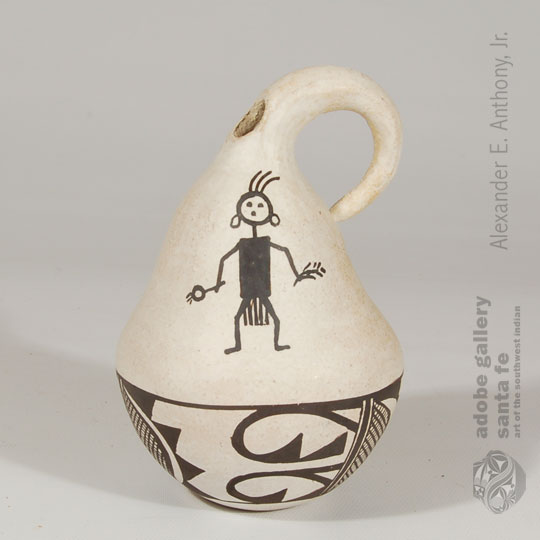 This pottery recreation of a prehistoric gourd pitcher is decorated with a pair of human figures on the upper section. It was purchased from Adobe Gallery in 1997 by the current owner.
This pottery recreation of a prehistoric gourd pitcher is decorated with a pair of human figures on the upper section. It was purchased from Adobe Gallery in 1997 by the current owner.
Juana Leno (1917-2000) Syo-ee-mee (Turquoise) - formerly Juana Louis Vallo - was one of the finest potters of the 20th century at Acoma Pueblo. She quietly worked every day producing extraordinary pottery without seeking acclaim. She was a wonderful woman and very modest about her talent to produce such fine pieces. She may not have achieved the fame she was due, but it was not because of the lack of quality in her work, but because she chose to remain quietly at home and not seek fame.
To purchase or read more click here..
#adobegallery #SouthwestIndianPottery #AcomaPueblo #PuebloPottery #SouthwestIndianArt #SantaFePottery #FinePuebloPottery #JuanaLeno
Acoma Pueblo Human Effigy Pitcher by Juana Leno - C4058B
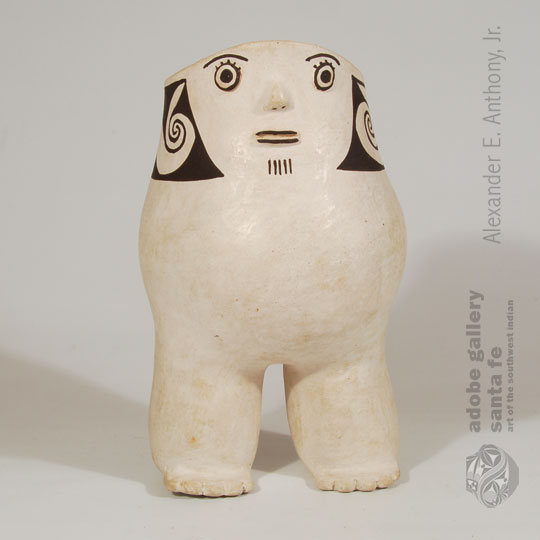 This pitcher was cleverly made in a human shape with a handle on the back side. He stands firmly without aid. This one dates to the late 1990s and was purchased from Adobe Gallery in 1997 and was made by Juana Leno (1917-2000) Syo-ee-mee (Turquoise).
This pitcher was cleverly made in a human shape with a handle on the back side. He stands firmly without aid. This one dates to the late 1990s and was purchased from Adobe Gallery in 1997 and was made by Juana Leno (1917-2000) Syo-ee-mee (Turquoise).
Juana Leno - formerly Juana Louis Vallo - was one of the finest potters of the 20th century at Acoma Pueblo. She quietly worked every day producing extraordinary pottery without seeking acclaim. She was a wonderful woman and very modest about her talent to produce such fine pieces.
To purchase or read more click here..
#adobegallery #SouthwestIndianPottery #AcomaPueblo #PuebloPottery #SouthwestIndianArt #SantaFePottery #FinePuebloPottery #JuanaLeno
Acoma Pueblo Triple Canteen with Tularosa Design by Juana Leno - C4058A
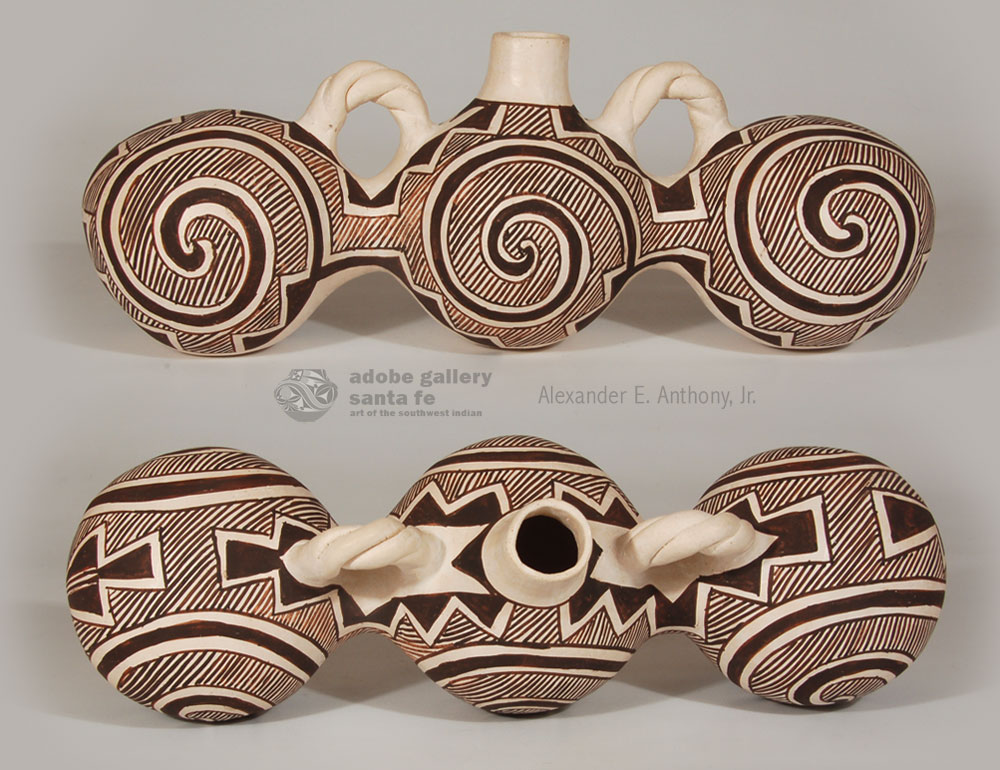 Juana Leno (1917-2000)Syo-ee-mee (Turquoise) is responsible for reintroducing this prehistoric design triple canteen into modern times. This one dates from the early 1990s and was purchased by the current owner in 1994. The Tularosa design goes back a millennium.
Juana Leno (1917-2000)Syo-ee-mee (Turquoise) is responsible for reintroducing this prehistoric design triple canteen into modern times. This one dates from the early 1990s and was purchased by the current owner in 1994. The Tularosa design goes back a millennium.
Juana Leno - formerly Juana Louis Vallo - was one of the finest potters of the 20th century at Acoma Pueblo. She quietly worked every day producing extraordinary pottery without seeking acclaim. She was a wonderful woman and very modest about her talent to produce such fine pieces. She may not have achieved the fame she was due, but it was not because of the lack of quality in her work, but because she chose to remain quietly at home and not seek fame.
To purchase or read more click here..
#adobegallery #SouthwestIndianPottery #AcomaPueblo #PuebloPottery #SouthwestIndianArt #SantaFePottery #FinePuebloPottery #JuanaLeno
Prehistoric Style Duck Effigy Pitcher by Juana Leno - C4058D
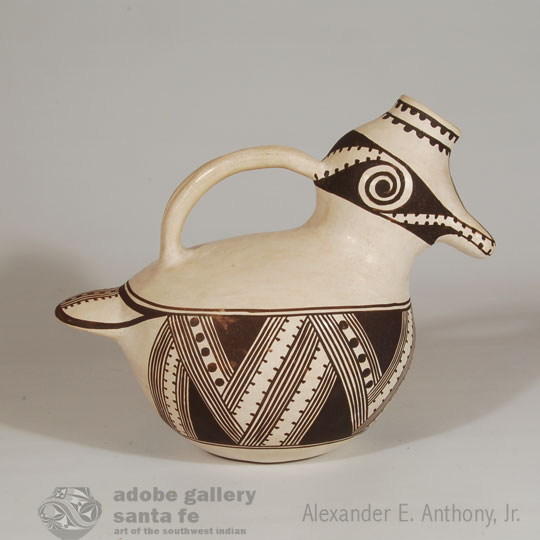 This Duck effigy pitcher is Juana Leno's recreation of a prehistoric Mimbres vessel. It was purchased from Adobe Gallery in 1997.
This Duck effigy pitcher is Juana Leno's recreation of a prehistoric Mimbres vessel. It was purchased from Adobe Gallery in 1997.
Juana Leno (1917-2000) Syo-ee-mee (Turquoise) - formerly Juana Louis Vallo - was one of the finest potters of the 20th century at Acoma Pueblo. She quietly worked every day producing extraordinary pottery without seeking acclaim. She was a wonderful woman and very modest about her talent to produce such fine pieces. She may not have achieved the fame she was due, but it was not because of the lack of quality in her work, but because she chose to remain quietly at home and not seek fame.
To purchase or read more click here..
#adobegallery #SouthwestIndianPottery #AcomaPueblo #PuebloPottery #SouthwestIndianArt #SantaFePottery #FinePuebloPottery #Historic #JuanaLeno
Acoma Pueblo Three Piece set of Pottery Whistles by Juana Leno - C4058G
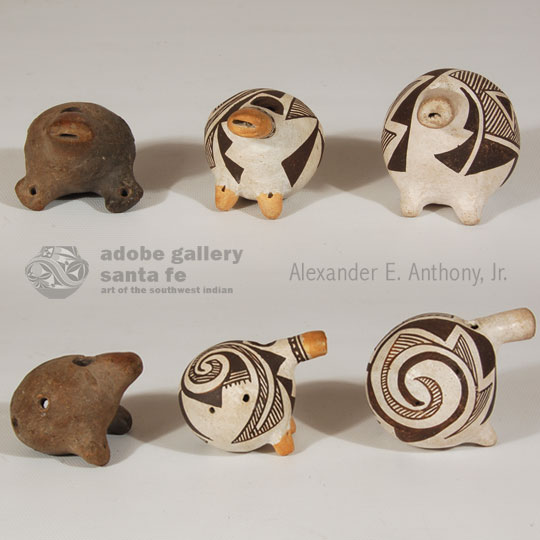 Juana Leno (1917-2000) Syo-ee-mee (Turquoise) - formerly Juana Louis Vallo - was one of the finest potters of the 20th century at Acoma Pueblo. She quietly worked every day producing extraordinary pottery without seeking acclaim. She was a wonderful woman and very modest about her talent to produce such fine pieces. She may not have achieved the fame she was due, but it was not because of the lack of quality in her work, but because she chose to remain quietly at home and not seek fame.
Juana Leno (1917-2000) Syo-ee-mee (Turquoise) - formerly Juana Louis Vallo - was one of the finest potters of the 20th century at Acoma Pueblo. She quietly worked every day producing extraordinary pottery without seeking acclaim. She was a wonderful woman and very modest about her talent to produce such fine pieces. She may not have achieved the fame she was due, but it was not because of the lack of quality in her work, but because she chose to remain quietly at home and not seek fame.
To purchase or read more click here..
#adobegallery #SouthwestIndianPottery #AcomaPueblo #PuebloPottery #SouthwestIndianArt #SantaFePottery #FinePuebloPottery #JuanaLeno
Unique and Unusual Southwest Pueblo Indian Pottery Exhibit
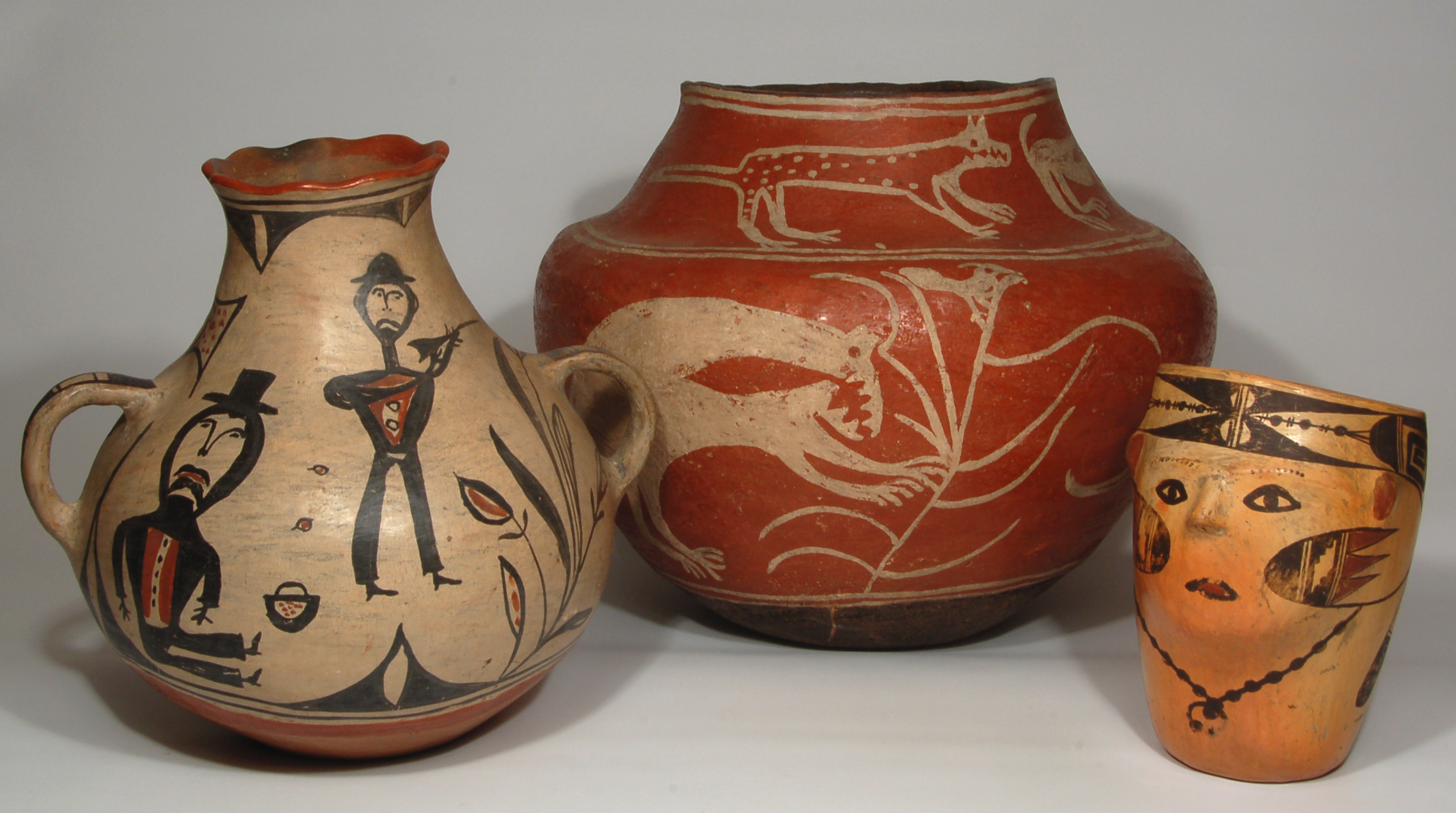 The Atchison, Topeka and Santa Fe Railway came to the American Southwest in the late 19th century, bringing with it a great deal of change for the region and its native inhabitants. The train brought a new brand of tourist: travelers from the East, looking for the exciting, romantic vision of the West that they'd heard and read about. These tourists wanted souvenirs to remind them of their Southwestern adventures.
The Atchison, Topeka and Santa Fe Railway came to the American Southwest in the late 19th century, bringing with it a great deal of change for the region and its native inhabitants. The train brought a new brand of tourist: travelers from the East, looking for the exciting, romantic vision of the West that they'd heard and read about. These tourists wanted souvenirs to remind them of their Southwestern adventures.
Adobe Gallery's new exhibit "Unique and Unusual Pueblo Pottery" is mostly focused on unsigned historic works created during this productive period of growth and change. A handful of notably unique contemporary pieces from artists like Tony Da and Maria Martinez are also included. All together, these pieces-wildly varied in size, shape, form and function-form an excellent display of the incredible skill and boundless creativity of Pueblo Indian potters.
"Unique and Unusual Pueblo Pottery" opens on Friday, April 6th, 2018, with reception from 5-7 p.m. "Unique and Unusual Pueblo Pottery" will highlight works from a variety of potters and Pueblos that are unique in form, design, function, or style.
To learn more about this exhibit click here..
Hopi Pueblo Tosonkoyemsi Katsina Doll - 26074
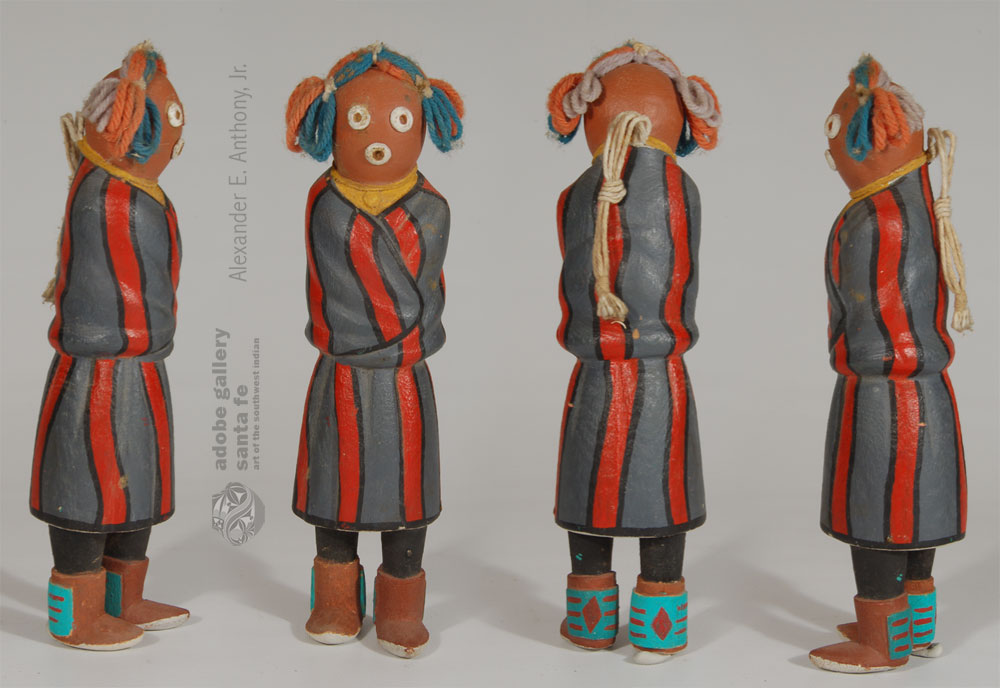 This katsina is known as the Toson Mudhead, Toson Koyemsi, and Mudhead Ogredepending on the reference book consulted. He is not an Ogre, however, but a relative of the family. The most proper term is Tosonkoyemsi Katsina. This is an indication of the variety of Koyemsi and their differing functions.
This katsina is known as the Toson Mudhead, Toson Koyemsi, and Mudhead Ogredepending on the reference book consulted. He is not an Ogre, however, but a relative of the family. The most proper term is Tosonkoyemsi Katsina. This is an indication of the variety of Koyemsi and their differing functions.
A number of the Tosonkoyemsi kachinas used to come with the Soyoko on Third Mesa and demand sweet cornmeal from the girls. They would then sit and taste the cornmeal to see if it was well-ground and sweet, and from this comes their name of Sweet Cornmeal Tasting Koyemsi. Since the Soyoko has not been performed on Third Mesa for over a half a century, this kachina no longer appears in this role, part of which is now played by Heheya Aumutaka. The Tosonkoyemsi does not appear on First Mesa, and the Second Mesa form is radically different.
To purchase or read more click here..
#adobegallery #HopiPueblo #Katsina #Kachina #Doll #SouthwestIndianArt #PuebloArt #SantaFeNM
Hopi Pueblo Second Mesa Laqan - Squirrel Katsina Doll - C4050A
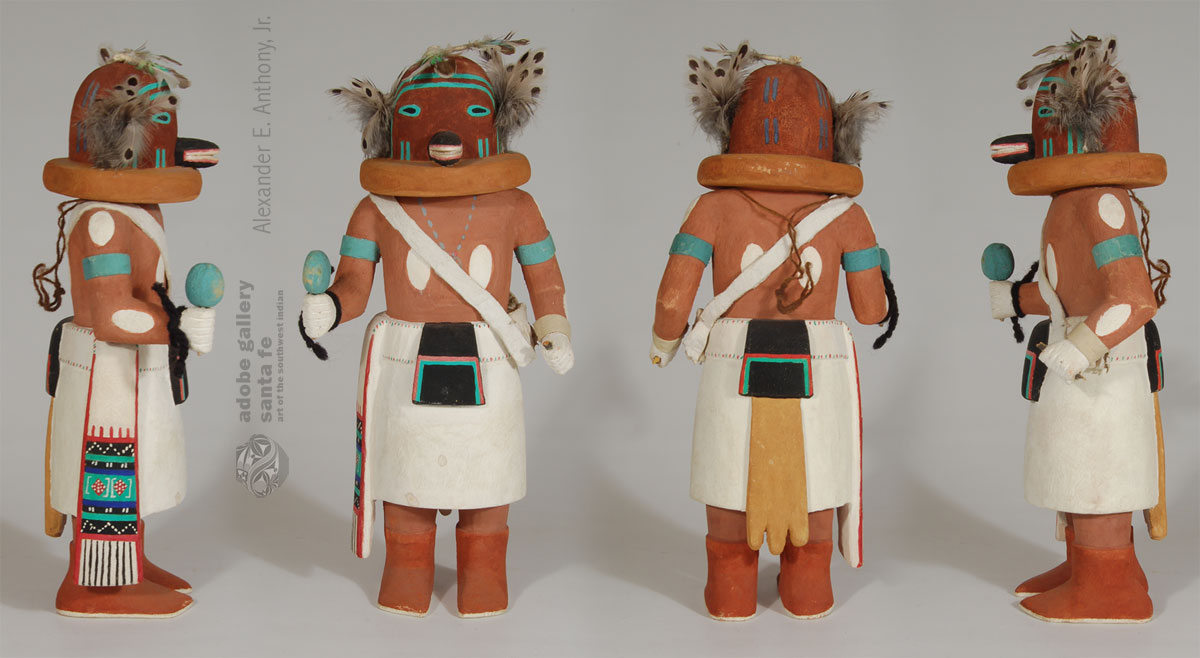 The Squirrel Katsina appears on all three mesas but has two distinct forms. This one is from Second Mesa, distinctive because of feather ears.
The Squirrel Katsina appears on all three mesas but has two distinct forms. This one is from Second Mesa, distinctive because of feather ears.
During the kiva dances in winter he is supposed to challenge any woman to take from him anything that she thinks worth having. He also may appear at Powamu or in the plaza dances in large numbers.
This carving appears to be circa 1950s. He is all wood except for the medicine bag he carries over his shoulder and the feathers on his head.
To purchase or read more click here..
#adobegallery #HopiPueblo #Katsina #Kachina #Doll #SouthwestIndianArt #PuebloArt #SantaFeNM
Hopi Pueblo Hemsona - He Cuts Your Hair Katsina Doll - C4050i
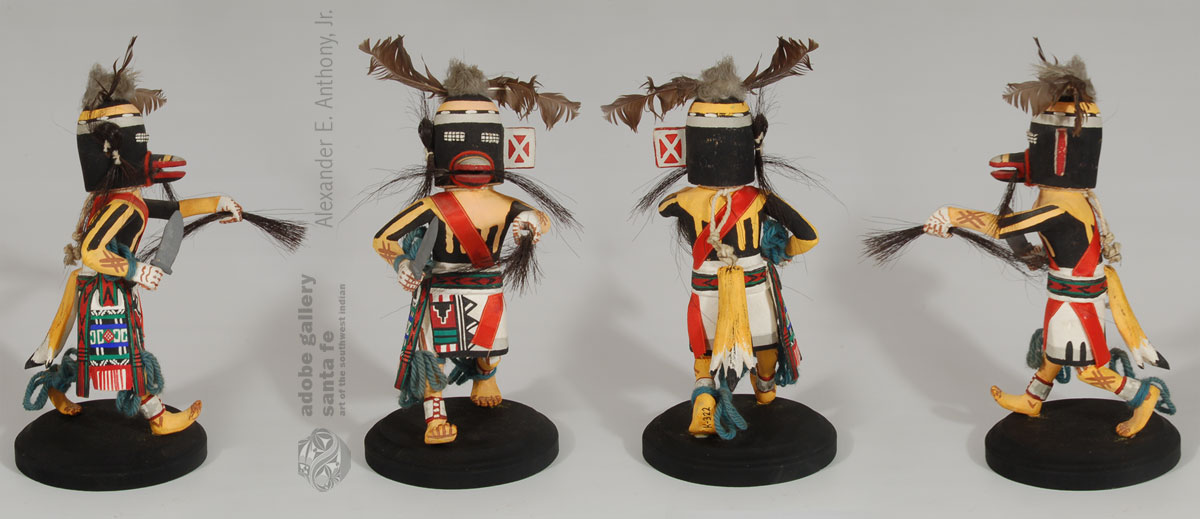 This katsina is a Runner Katsina and one of the very few Runners who consistently appear in elaborate costuming. Normally, Runners wear very little clothing, to facilitate speed in running. He appears on all three Mesas and his action is to catch another katsina and cut off a lock of his hair.
This katsina is a Runner Katsina and one of the very few Runners who consistently appear in elaborate costuming. Normally, Runners wear very little clothing, to facilitate speed in running. He appears on all three Mesas and his action is to catch another katsina and cut off a lock of his hair.
Most of the dances that are given in the plaza in late spring are accompanied by additional katsinas who may not be dancers. Often a group of katsinas known as Wawarus Katsinas or runners will appear and run races with the men and boys of the village. They come in the late spring, either as a group or as individuals, during a pause in a Mixed or Plaza Dance. Usually they will select one end of the Plaza and, assembling there, will endeavor to have an individual race. If there are many Wawarus, there will be a great churning about with one or another racing down the length of the Plaza and others prancing up and down to ready themselves for the coming contest.
To purchase or read more click here..
#adobegallery #HopiPueblo #Katsina #Kachina #Doll #SouthwestIndianArt #PuebloArt #SantaFeNM
Traditional Hopi Pueblo Chakwaina Katsina Doll - C4050J
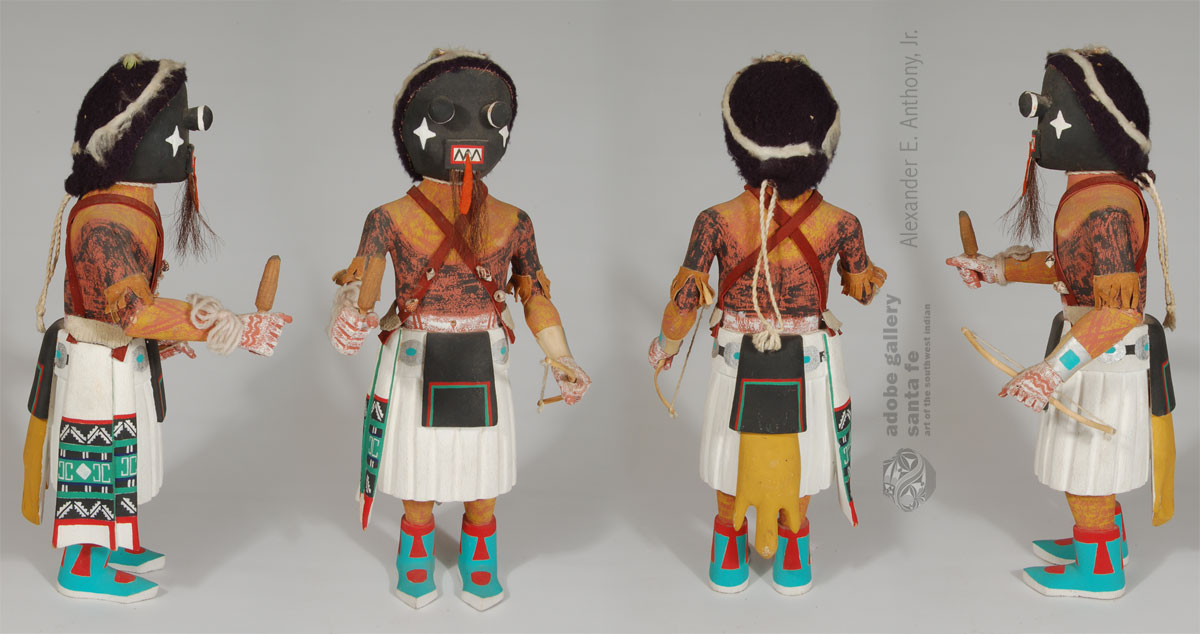 This katsina doll, probably from the 1950s, represents Chakwaina who appears most often in January during the Kiva Dances, dancing in a line with lively gestures, stooping and turning and singing a spirited tune. It has been said that Chakwaina represents Estevan the Moor, who led Fray Marcos de Niza in search of Cibola and was killed at Zuni. Barton Wright, the noted Katsina expert, said this is not likely because Chakwaina originally came from the Rio Grande Pueblos, migrated to Zuni, then to Hopi from Zuni.
This katsina doll, probably from the 1950s, represents Chakwaina who appears most often in January during the Kiva Dances, dancing in a line with lively gestures, stooping and turning and singing a spirited tune. It has been said that Chakwaina represents Estevan the Moor, who led Fray Marcos de Niza in search of Cibola and was killed at Zuni. Barton Wright, the noted Katsina expert, said this is not likely because Chakwaina originally came from the Rio Grande Pueblos, migrated to Zuni, then to Hopi from Zuni.
Chakwaina appears at Hopi, Zuni and *Keresan Pueblos but not in New Mexico Tewa Pueblo ceremonies. Chakwaina is a warrior of great repute.
To purchase or read more click here..
#adobegallery #HopiPueblo #Katsina #Kachina #Doll #SouthwestIndianArt #PuebloArt #SantaFeNM
Hopi Pueblo Tall and Slim Crow Mother Katsina Doll - C4045C
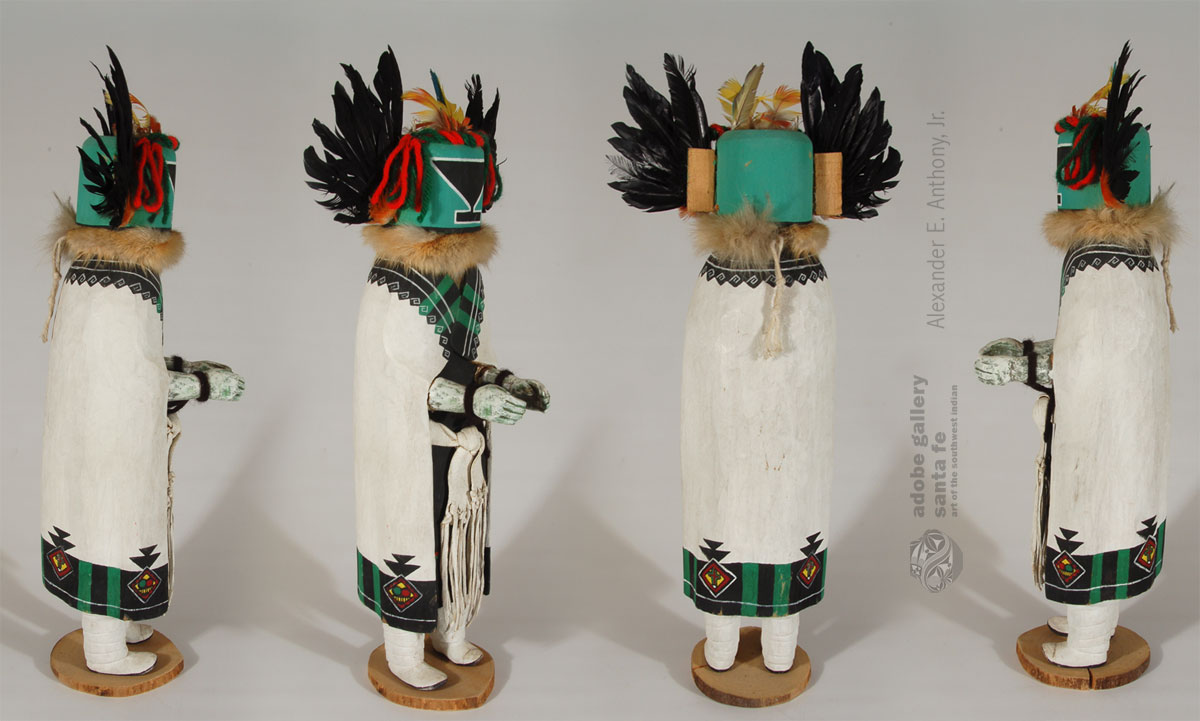 Crow Mother is a female katsina, however, she is always personated by a male, as are all female katsinas. The carver well illustrated that this is a tall man. The body style is that of a young man, tall and slim. The doll is basically a complete wood carving but embellished with other materials-leather white wedding sash, fur neck ruff, and yarn and feathers on the head. She has a string for hanging on a wall and a pedestal for display on a flat surface. The pedestal is easily removable should one wish to display her on a wall. The carving appears to have been completely accomplished with a knife as beautifully illustrated on the white manta. There was no attempt, fortunately, by the carver to sand away the knife marks.
Crow Mother is a female katsina, however, she is always personated by a male, as are all female katsinas. The carver well illustrated that this is a tall man. The body style is that of a young man, tall and slim. The doll is basically a complete wood carving but embellished with other materials-leather white wedding sash, fur neck ruff, and yarn and feathers on the head. She has a string for hanging on a wall and a pedestal for display on a flat surface. The pedestal is easily removable should one wish to display her on a wall. The carving appears to have been completely accomplished with a knife as beautifully illustrated on the white manta. There was no attempt, fortunately, by the carver to sand away the knife marks.
As we explained recently when posting another Crow Mother Katsina doll, there are two functions for which she is known-one is as Crow Mother and the other as Crow Bride. We repeat that explanation for those who missed it recently.
To purchase or read more click here..
#adobegallery #HopiPueblo #Katsina #Kachina #Doll #SouthwestIndianArt #PuebloArt #SantaFeNM
Silakafgoingtaka - Tewa Whipper Katsina Doll - C4050D
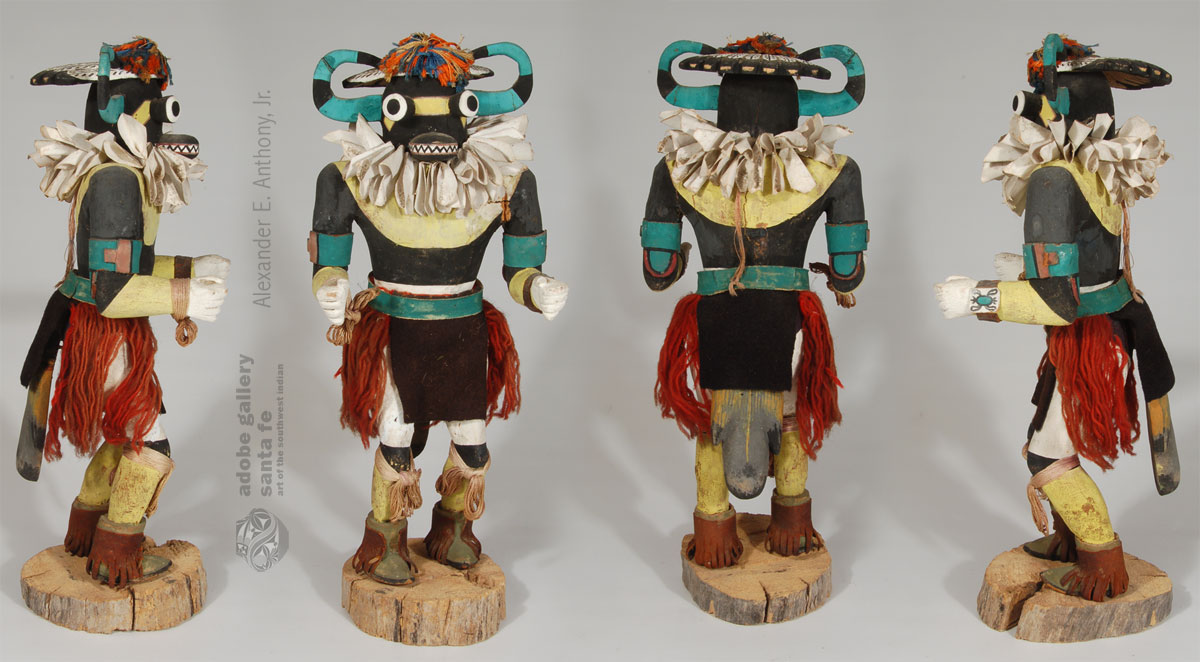 This Silakafgoingtaka - Tewa Whipper Katsina Doll is a Tewa Katsina from First Mesa. The Hopi name is Silakafgoingtaka and the Tewa name is Ga wong-ping. He is considered a Tewa Whipper Katsina and is not a Hopi Katsina, although the Hopi have a name for it. In other words, this is a Hopi Pueblo carving of a Tewa Katsina.
This Silakafgoingtaka - Tewa Whipper Katsina Doll is a Tewa Katsina from First Mesa. The Hopi name is Silakafgoingtaka and the Tewa name is Ga wong-ping. He is considered a Tewa Whipper Katsina and is not a Hopi Katsina, although the Hopi have a name for it. In other words, this is a Hopi Pueblo carving of a Tewa Katsina.
The sole purpose of this katsina is the initiation of the kids into the Tewa kivas, and he comes usually in pairs prior to the Bean Dance to conduct the initiation. He appears in February to initiate the children who have come of age, and he appears four days prior to Bean Dance.
This katsina wears a sack-type face made from a net. His ruff consists of dried corn husks, and he wears a hair roach made from wild flowers. The illustration in the referenced book below does not have horns as shown on this doll, and this doll does not carry yucca whips in his hands as illustrated in the reference. Perhaps there are variations in style at the different villages.
To purchase or read more click here..
#adobegallery #HopiPueblo #Katsina #Kachina #Doll #SouthwestIndianArt #PuebloArt #SantaFeNM
Santa Clara Pueblo Small Red Bowl with Handles by Teresita Naranjo - C4051B
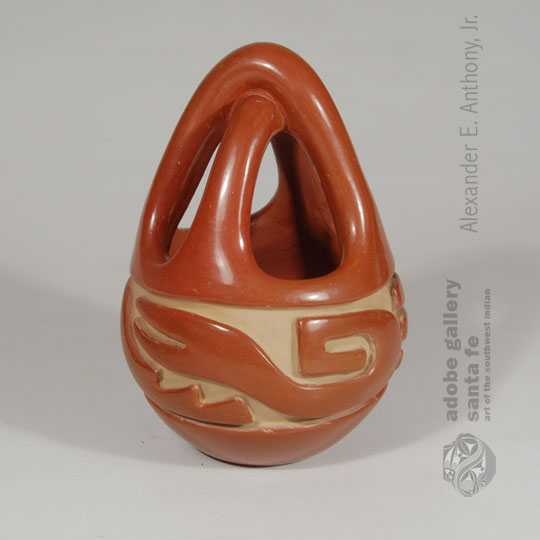 Teresita Tafoya Naranjo (1919-1999) Apple Blossom - Bay-Po-Vi was the daughter of Christina Naranjo and granddaughter of Sara Fina Tafoya. She has been acknowledged as one of the finest 20th century potters at Santa Clara Pueblo. Her unexpected death in 1999 was a loss to all pottery collectors.
Teresita Tafoya Naranjo (1919-1999) Apple Blossom - Bay-Po-Vi was the daughter of Christina Naranjo and granddaughter of Sara Fina Tafoya. She has been acknowledged as one of the finest 20th century potters at Santa Clara Pueblo. Her unexpected death in 1999 was a loss to all pottery collectors.
She was active from 1935 to 1999 and was known for her black and red carved works in the Santa Clara style. After her husband passed away in 1950, she supported her family solely through sales of her pottery.
To purchase or read more click here..
#adobegallery #SouthwestIndianPottery #SantaClaraPueblo #PuebloPottery #SouthwestIndianArt #SantaFePottery #FinePuebloPottery #Historic #TeresitaNaranjo
Black-on-black Feather Design Plate signed Marie and Santana - C3512.23
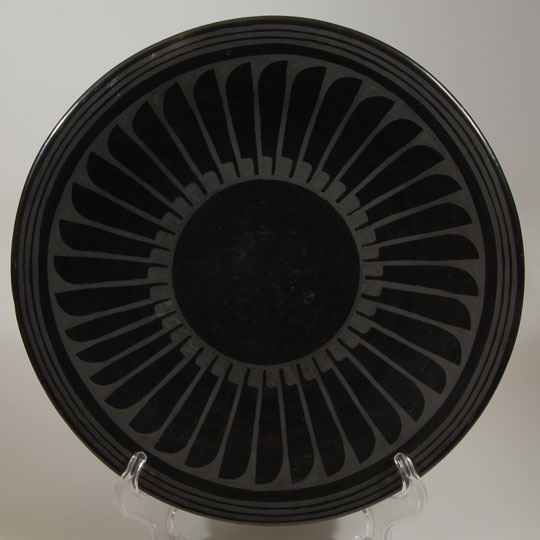 This plate is signed Marie & Santana, an earlier signature, indicating that it was made from mid-1940s to mid-1950s. Santana had started assisting Maria following the death of Julian in 1943. Maria made the plate and Santana decorated it with 37 individual feathers fanned out in a circle. This was a favorite design of Julian and Santana continued its use.
This plate is signed Marie & Santana, an earlier signature, indicating that it was made from mid-1940s to mid-1950s. Santana had started assisting Maria following the death of Julian in 1943. Maria made the plate and Santana decorated it with 37 individual feathers fanned out in a circle. This was a favorite design of Julian and Santana continued its use.
Purchase or read more click here.
#adobegallery #SouthwestIndianPottery #SanIldefonsoPueblo #PuebloPottery #SouthwestIndianArt #SantaFePottery #FinePuebloPottery #Historic #MariaMartinez
Historic Laguna Pueblo Four Color Polychrome Small Jar - C4047C
Refugees from Acoma, Zuni and other pueblos established Laguna Pueblo a few years after the Pueblo Revolt of 1680. Its date of establishment was 1699. As a result, its pottery can be very similar to that of Acoma and Zuni Pueblos, and, for the most part, is indistinguishable from ceramics at Acoma, but not so much from that at Zuni except for similarity in design elements. Acoma and Laguna clay are similar but Zuni clay differs from that at those two pueblos. Sometimes designs must be used as a guideline for distinguishing ceramics at Laguna.
The domino shaped black bars on the neck with a white split in their centers are very typical of pottery designs used at Laguna. Also, the plant with berries is a traditional design element from Laguna, a design that Laguna potters took with them when many of them moved to Isleta Pueblo. It has since become an Isleta Pueblo design. It is such design elements as these that distinguish Laguna pottery from that of Acoma.
To purchase or read more click here..
#adobegallery #SouthwestIndianPottery #LagunaPueblo #LagunaPottery #PuebloPottery #SouthwestIndianArt #SantaFePottery #FinePuebloPottery #HistoricPottery
Carved Santa Clara Pueblo Red Globular Jar by Autumn Borts Medlock - C4047P
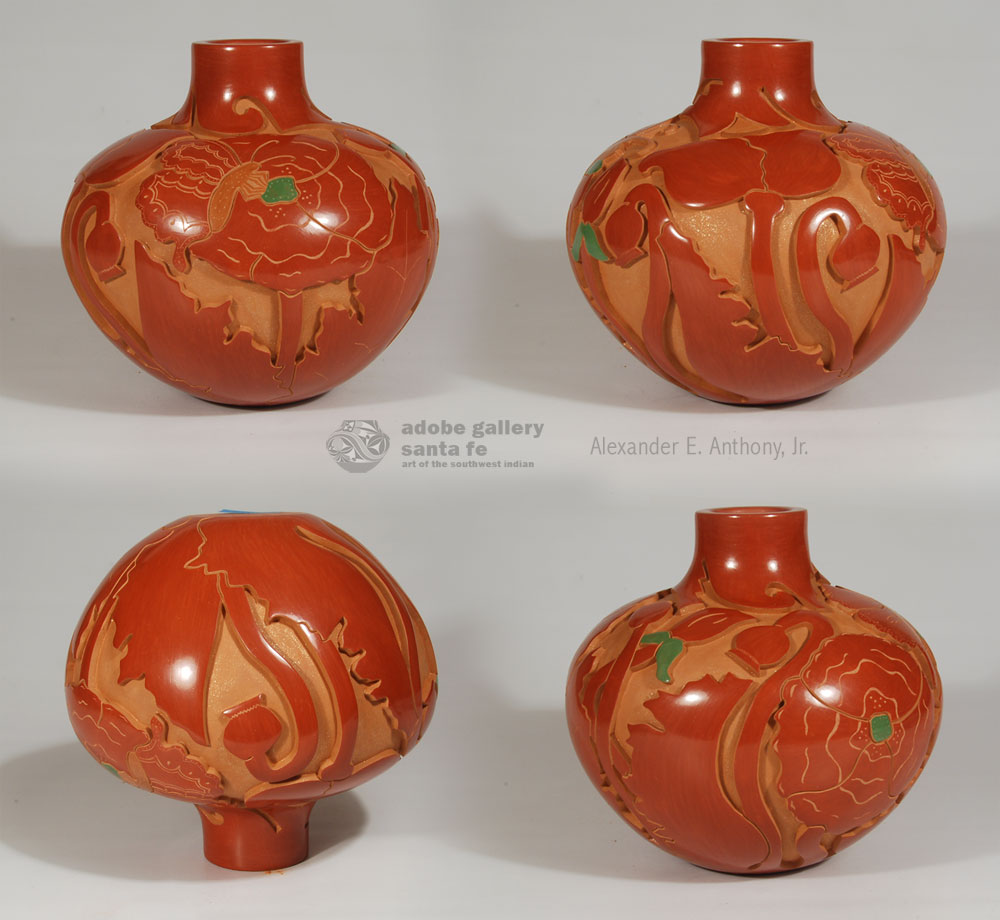 This contemporary pottery jar appears to be a celebration of spring with tulips and poppies about ready to bloom. The flowers that hang down are poppies and the erect ones are tulips. There are two butterflies busily pollinating the open ones. The artist highlighted the leaves with green pigment, probably a natural mineral source. The carving is deep into the clay body and expertly rendered. Each carved line is clean and precise. The area of the vessel exposed behind the carving was slipped with micaceous clay. The red slip was highly burnished with a stone.
This contemporary pottery jar appears to be a celebration of spring with tulips and poppies about ready to bloom. The flowers that hang down are poppies and the erect ones are tulips. There are two butterflies busily pollinating the open ones. The artist highlighted the leaves with green pigment, probably a natural mineral source. The carving is deep into the clay body and expertly rendered. Each carved line is clean and precise. The area of the vessel exposed behind the carving was slipped with micaceous clay. The red slip was highly burnished with a stone.
To Purchase or read more click here..
#adobegallery #SouthwestIndianPottery #SantaClaraPueblo #PuebloPottery #SantaFePottery #FinePuebloPottery #SantaFeNM #AutumnBortsMedlock
Mixed Media Collage Monotype of Navajo Yei Figure by Tony Abeyta - C4046
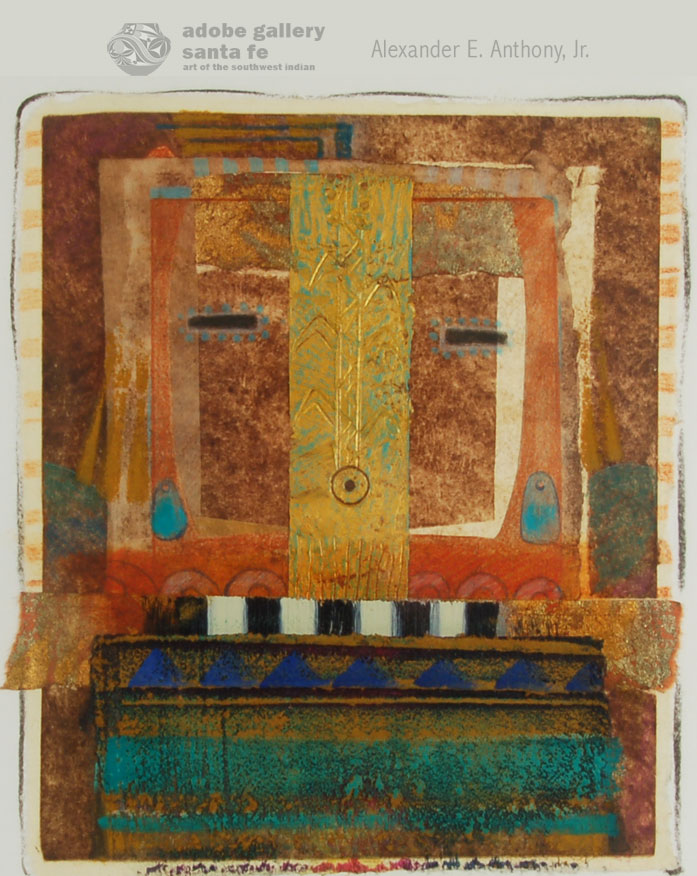 Navajo painter Tony Abeyta is one of the best and most collectible contemporary Native American artists of today. Abeyta was educated at Santa Fe's Institute of American Indian Art, the Maryland Institute College of Art in Baltimore, and overseas in Italy and Southern France. He later returned to school, taking postgraduate classes in art and filmmaking at the Chicago Art Institute. He is known for his singular style of New Mexico landscapes and his richly textured mixed media depictions of Navajo Yei Figures.
Navajo painter Tony Abeyta is one of the best and most collectible contemporary Native American artists of today. Abeyta was educated at Santa Fe's Institute of American Indian Art, the Maryland Institute College of Art in Baltimore, and overseas in Italy and Southern France. He later returned to school, taking postgraduate classes in art and filmmaking at the Chicago Art Institute. He is known for his singular style of New Mexico landscapes and his richly textured mixed media depictions of Navajo Yei Figures.
To purchase or read more click here..
#adobegallery #SouthwestIndianPainting #NativeAmericanPainting #FineArt #Painting #Navajo #Diné #SantaFeNM #FinePuebloPainting #TonyAbeyta
Hopi Pueblo Polychrome Jar with Unusual Design by Nampeyo of Hano - C4047i
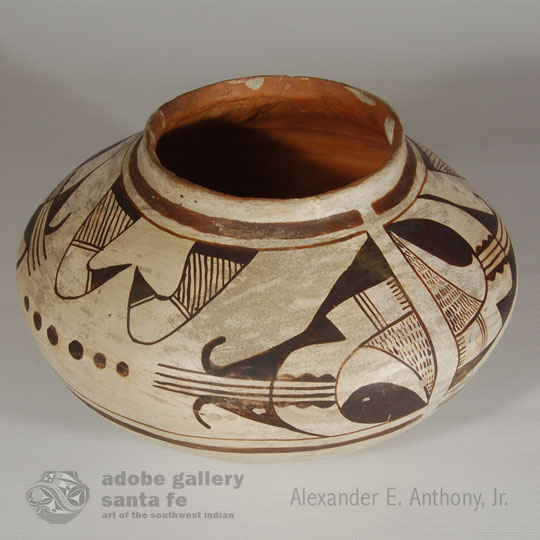 Nampeyo of Hano (1857-1942) is associated by most collectors as a potter who reintroduced Sikyatki pottery designs. That is accurate, but Nampeyo also was a genius at creating her own designs before she began with the Sikyatki ones. This jar, probably circa 1900, is an excellent example of a jar by Nampeyo with designs by Nampeyo. Here, she created a large design, split vertically into two similar sections. The long curved "arm" with multiple lines at the end is probably a weaving comb, not an arm with too many fingers. The triangles with rows of short parallel lines might possibly represent corn fields. The pair of designs pendant from the framing line just below the rim, perhaps are birds or perhaps are just designs that have no definition. The unusual design is the row of six dots. Marti Struever stated that it was a "rare design of dots."
Nampeyo of Hano (1857-1942) is associated by most collectors as a potter who reintroduced Sikyatki pottery designs. That is accurate, but Nampeyo also was a genius at creating her own designs before she began with the Sikyatki ones. This jar, probably circa 1900, is an excellent example of a jar by Nampeyo with designs by Nampeyo. Here, she created a large design, split vertically into two similar sections. The long curved "arm" with multiple lines at the end is probably a weaving comb, not an arm with too many fingers. The triangles with rows of short parallel lines might possibly represent corn fields. The pair of designs pendant from the framing line just below the rim, perhaps are birds or perhaps are just designs that have no definition. The unusual design is the row of six dots. Marti Struever stated that it was a "rare design of dots."
The design was executed in brown pigment on white slip. The rim appears to have been painted orange as an extension of the orange slip on the interior. The design is divided by a ceremonial line break that penetrates the framing lines and the design. The white color on the rim interior may appear to be a rim chip but it is a spot of white slip.
To purchase or read more click here..
#adobegallery #SouthwestIndianPottery #HopiPueblo #PuebloPottery #SouthwestIndianArt #SantaFePottery #FinePuebloPottery #Historic #NampeyoofHano

